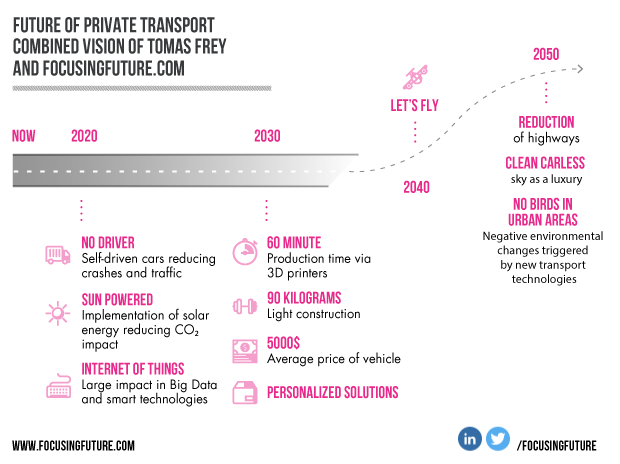![]() 5 minute read
5 minute read
The future of cars is already pretty known, the consequences of innovations is still a question. Let’s discuss the predictions, innovators, and existing examples of city private transportation in sustainable pespective.
Predicted for
the future
DaVince Institute is an important non-profit think tank for futurists with the valuable and real predictions. It was founded in 1997 by Google’s Top Rated Futuristic speaker Tomas Fray. He has delicately predicted the future of transport stating that electric automobiles and hybrids will be replacing traditional gas-powered autos starting from 2015. Besides, he forecasted that flying drones era will beginning the same year, and he was not mistaken. The drones as delivery men is a reality of 2015 and a part of Anticipatory Shopping[nbsp]project of Amazon. Therefore, we have decided to look into Tomas’s visions on private transportation in 2050; we strongly believe that future foreseen by Tomas will arrive earlier.
Combining our both visions here what we got:

Autonomous cars
as a solution
The driverless technology has so many advantages, that one can never stop admiring. Reducing 95% of car crashes, giving freedom of movement for disabled, escaping the traffic jams, and changing the understanding of transport sharing are first things that come in mind. In Urbanization period, when most of the world’s population will, and already lives, in the cities, the question of transportation is one of the most important, as well as the security of movement. Drivers are the most unreliable element of the car, therefore transport engineers are working on the elimination of that element from the system giving the car knowledge and experience of controlling the vehicle. Google and Tesla predict the fully-autonomous cars will be available on the mass market by 2020.
“I think it’s [autonomous driving] just going to become normal. Like an elevator. They used to have elevator operators, and then we developed some simple circuitry to have elevators just come to the floor that you’re at, you just press the button, “ says Elon Musk, CEO of Tesla Motors.
In reality it will feel like having the personal driver, just tell to the car where to drive and relax while getting there. This gives a large opportunity for car sharing practises in the cities. Self-driven cars can perform as mini-buses. Passenger informs the travel direction and time to the service, with a smartphone app for example. Computerised service analyses the incoming data and allocates the routes for the cars with picking up and dropping off the passengers on the way, providing each customer with safe and comfortable journey from A to B. This method assures the reduction of traffic and safety travel twenty-four-seven.
City powered
by vehicles
The dependence on gas is coming to an end, thanks to Tesla Powerwall breakthrough, a rechargeable lithium-ion battery, for electric vehicles and homes. This innovation opens the door for new and affordable solutions for renewable power storage. Transport powered by Sun is not the decent future. For example, Solar Impulse 2, the airplane attempting the first round-the-world solar flight, has set new solar aviation [&] longest solo flight world records. The electric vehicles with solar batteries are being tested and will be population-wide used in nearest future.
Alternatively, the promising energy source is[nbsp]hydrogen, extracted from the water. That is probably the most natural and affordable power source ever invented. The vehicle, implemented with the fuel cell, which converts hydrogen to electricity, is silent and creed, giving off only heat and water as byproducts. In addition, the produced by fuel cell heat can generate more electricity. It is not bold to say, that hydrogen car will produce enough energy to share it. The city powered by the cars – that’s a revolution in all meanings.
And don’t
forget the health
Copenhagen is probably the best example that transport of the future can be just a bicycle. With the right infrastructure the greenest vehicle, which besides all, supports the health, is the bottom of the urban culture. For example, London Major, Boris Johnson reports, that “bikes already make up 24 percent[nbsp]of all rush-hour traffic in central London.” In addition, London aims to build one of Europe’s most ambitious bicycle path called the East-West Cycle Superhighway. It will be the separated bicycle path connecting Barking in the east with Acton on the west of London, making about 30 kilometres in length.
Generally, having the history of more than 150 years, bicycle gains only bigger popularisation and adoption in the world, and the trend of expanding the opportunities will keep on going in the future.




